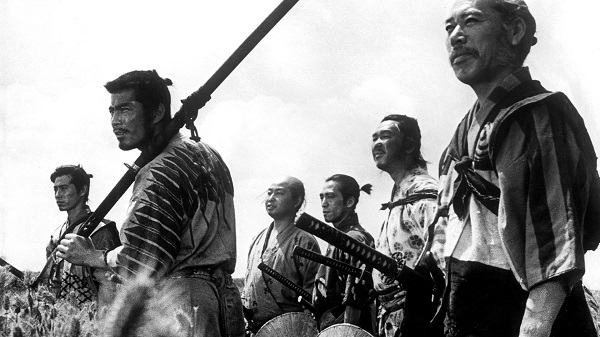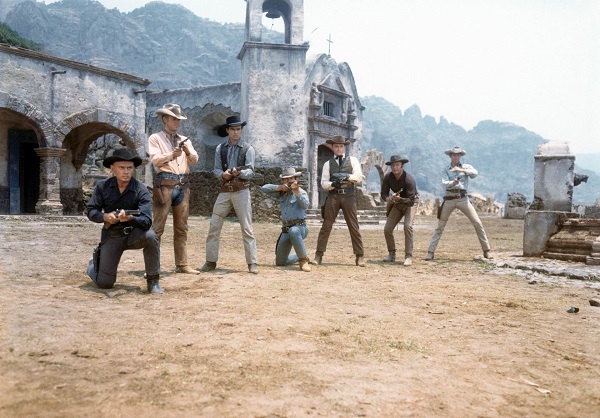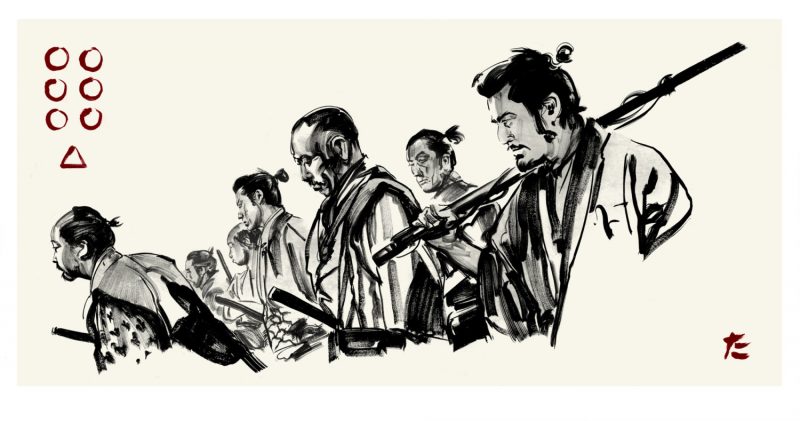Seven Samurai vs. The Magnificent Seven
"Spirit of the Seven"
If you go back to the 1954 Japanese epic historical drama
Seven Samurai, directed by the legendary and incomparable Akira Kurosawa, it isn’t too difficult to understand that the film will focus on well, seven samurai. However, when you begin to look a bit deeper, you grow to understand that the rewards of the story of seven warriors and their struggle, run much deeper than what’s on the surface of the title.
As audiences prepare to saddle up for Antoine Fuqua’s
The Magnificent Seven, which is a remake of the 1960 John Sturgess film of the same name, which in turn was essentially the American Hollywood version of Kurosawa’s
Samurai, Entertainment Fuse takes a look at these films in some form to celebrate the spirit of the Seven.

Before we dive too deeply into this, we must first understand that we should give credit where credit is due. There would be no
Magnificent Seven without Kurosawa's epic. Both versions of the western, as well as several other films, draw their inspiration from Kurusowa. In fact, it's probably safe to say that there was no samurai film proper, in the way that we know it today, before Kurusowa. Everything from
A Fistful of Dollars to
A Bug's Life, to even
Star Wars and to some extent,
Kung Fu Panda owes a debt of gratitude to Kurosowa's body of work.
The basic premise is the same in each film. You have a peaceful village being raided and overpowered on a number of occasions by outsiders looking for resources. A search for the means of protection for the village ensues. After some form of initial resistance, protection comes in the form of seven men who come together from different places in life in order to achieve a common goal. Of course, much action and drama take place, eventually leading up to a climactic battle between the seven men, the villagers who fight with them and the opposition.

The biggest difference between the three films is the more ethnically diverse cast, as can be seen in the Fuqua remake whereas both
Seven Samurai and the original
Magnificent Seven feature either all Japanese powerhouse actors or all white superstar actors in the respective roles of the Seven. Culturally obviously, the film's are different as well. Many of tropes and types in terms of characters and themes are translatable regardless of time or ethnic background however, context is crucial, particularly when looking at
Seven Samurai. Made less than a decade following World War II, the world was still getting itself back together.
Samurai is set at a point in time where at least one part of the world is not together at all: Feudal Japan, where civil war and unrest is the reality. Complete with clear class issues, extreme poverty, and miserable circumstances. Kurosowa deeply examines such circumstances and how they effect the people who live within them.
Another huge difference is the social status of the heroes. In both versions of
The Magnificent Seven, the heroes are essentially where they are by choice. They are outlaws because they choose to be and can change that anytime they so wish. However, this is not the case for the samurai predecessors. The Seven in
Samurai are members of a group of professional, highly trained warriors of important social status. They fight because it is all they have been trained to do. Going and getting a job somewhere else would be much harder for them because this is the role they are playing in Japanese society and they are more or less confined to that space.

The villagers are also a much more integral piece of Kurosowa's film and very much a part of the key story in a way that is organically rooted and is just as important as the story of the Seven. This isn't the case in
The Magnificent Seven, where the villagers are essentially around to give the Seven a purpose for the main conflict with the main villain, which doesn't feel like it carries as much weight. It's probably a fair bet that this same aspect rings true in the updated remake.
Given that Kurosawa was a rather lyrical and introspective filmmaker, it isn't hard to see that
Samurai is clearly the more emotionally compelling version and clocking in at three and a half hours, there is plenty of room for scenes to breathe. Hollywood style versions of films are historically less about introspection and more about cranking out easily digestible fare and
The Magnificent Seven is very much a part of that system. Yet with such a strong foundation, it is understandable how it is still regarded as one of the best westerns ever made.

In a recent interview, Antoine Fuqua said, "I went back to Kurosawa’s
Seven Samurai and said, “What was Kurosawa trying to say?” And the word “samurai” means “to serve.” And I said, “Well, that’s it.” That’s the story: It’s about “in service of others." With that, what function does a movie serve? To entertain, to make us think and feel, to allow us to dream, right? Kurosowa's
Seven Samurai and John Sturgess' T
he Magnificent Seven fulfills all of these functions. Given the all star cast that Fuqua has assembled for his take on the Seven, there is little doubt that his offering will satisfy these functions too.
 Before we dive too deeply into this, we must first understand that we should give credit where credit is due. There would be no Magnificent Seven without Kurosawa's epic. Both versions of the western, as well as several other films, draw their inspiration from Kurusowa. In fact, it's probably safe to say that there was no samurai film proper, in the way that we know it today, before Kurusowa. Everything from A Fistful of Dollars to A Bug's Life, to even Star Wars and to some extent, Kung Fu Panda owes a debt of gratitude to Kurosowa's body of work.
The basic premise is the same in each film. You have a peaceful village being raided and overpowered on a number of occasions by outsiders looking for resources. A search for the means of protection for the village ensues. After some form of initial resistance, protection comes in the form of seven men who come together from different places in life in order to achieve a common goal. Of course, much action and drama take place, eventually leading up to a climactic battle between the seven men, the villagers who fight with them and the opposition.
Before we dive too deeply into this, we must first understand that we should give credit where credit is due. There would be no Magnificent Seven without Kurosawa's epic. Both versions of the western, as well as several other films, draw their inspiration from Kurusowa. In fact, it's probably safe to say that there was no samurai film proper, in the way that we know it today, before Kurusowa. Everything from A Fistful of Dollars to A Bug's Life, to even Star Wars and to some extent, Kung Fu Panda owes a debt of gratitude to Kurosowa's body of work.
The basic premise is the same in each film. You have a peaceful village being raided and overpowered on a number of occasions by outsiders looking for resources. A search for the means of protection for the village ensues. After some form of initial resistance, protection comes in the form of seven men who come together from different places in life in order to achieve a common goal. Of course, much action and drama take place, eventually leading up to a climactic battle between the seven men, the villagers who fight with them and the opposition.
 The biggest difference between the three films is the more ethnically diverse cast, as can be seen in the Fuqua remake whereas both Seven Samurai and the original Magnificent Seven feature either all Japanese powerhouse actors or all white superstar actors in the respective roles of the Seven. Culturally obviously, the film's are different as well. Many of tropes and types in terms of characters and themes are translatable regardless of time or ethnic background however, context is crucial, particularly when looking at Seven Samurai. Made less than a decade following World War II, the world was still getting itself back together. Samurai is set at a point in time where at least one part of the world is not together at all: Feudal Japan, where civil war and unrest is the reality. Complete with clear class issues, extreme poverty, and miserable circumstances. Kurosowa deeply examines such circumstances and how they effect the people who live within them.
Another huge difference is the social status of the heroes. In both versions of The Magnificent Seven, the heroes are essentially where they are by choice. They are outlaws because they choose to be and can change that anytime they so wish. However, this is not the case for the samurai predecessors. The Seven in Samurai are members of a group of professional, highly trained warriors of important social status. They fight because it is all they have been trained to do. Going and getting a job somewhere else would be much harder for them because this is the role they are playing in Japanese society and they are more or less confined to that space.
The biggest difference between the three films is the more ethnically diverse cast, as can be seen in the Fuqua remake whereas both Seven Samurai and the original Magnificent Seven feature either all Japanese powerhouse actors or all white superstar actors in the respective roles of the Seven. Culturally obviously, the film's are different as well. Many of tropes and types in terms of characters and themes are translatable regardless of time or ethnic background however, context is crucial, particularly when looking at Seven Samurai. Made less than a decade following World War II, the world was still getting itself back together. Samurai is set at a point in time where at least one part of the world is not together at all: Feudal Japan, where civil war and unrest is the reality. Complete with clear class issues, extreme poverty, and miserable circumstances. Kurosowa deeply examines such circumstances and how they effect the people who live within them.
Another huge difference is the social status of the heroes. In both versions of The Magnificent Seven, the heroes are essentially where they are by choice. They are outlaws because they choose to be and can change that anytime they so wish. However, this is not the case for the samurai predecessors. The Seven in Samurai are members of a group of professional, highly trained warriors of important social status. They fight because it is all they have been trained to do. Going and getting a job somewhere else would be much harder for them because this is the role they are playing in Japanese society and they are more or less confined to that space.
 The villagers are also a much more integral piece of Kurosowa's film and very much a part of the key story in a way that is organically rooted and is just as important as the story of the Seven. This isn't the case in The Magnificent Seven, where the villagers are essentially around to give the Seven a purpose for the main conflict with the main villain, which doesn't feel like it carries as much weight. It's probably a fair bet that this same aspect rings true in the updated remake.
Given that Kurosawa was a rather lyrical and introspective filmmaker, it isn't hard to see that Samurai is clearly the more emotionally compelling version and clocking in at three and a half hours, there is plenty of room for scenes to breathe. Hollywood style versions of films are historically less about introspection and more about cranking out easily digestible fare and The Magnificent Seven is very much a part of that system. Yet with such a strong foundation, it is understandable how it is still regarded as one of the best westerns ever made.
The villagers are also a much more integral piece of Kurosowa's film and very much a part of the key story in a way that is organically rooted and is just as important as the story of the Seven. This isn't the case in The Magnificent Seven, where the villagers are essentially around to give the Seven a purpose for the main conflict with the main villain, which doesn't feel like it carries as much weight. It's probably a fair bet that this same aspect rings true in the updated remake.
Given that Kurosawa was a rather lyrical and introspective filmmaker, it isn't hard to see that Samurai is clearly the more emotionally compelling version and clocking in at three and a half hours, there is plenty of room for scenes to breathe. Hollywood style versions of films are historically less about introspection and more about cranking out easily digestible fare and The Magnificent Seven is very much a part of that system. Yet with such a strong foundation, it is understandable how it is still regarded as one of the best westerns ever made.
 In a recent interview, Antoine Fuqua said, "I went back to Kurosawa’s Seven Samurai and said, “What was Kurosawa trying to say?” And the word “samurai” means “to serve.” And I said, “Well, that’s it.” That’s the story: It’s about “in service of others." With that, what function does a movie serve? To entertain, to make us think and feel, to allow us to dream, right? Kurosowa's Seven Samurai and John Sturgess' The Magnificent Seven fulfills all of these functions. Given the all star cast that Fuqua has assembled for his take on the Seven, there is little doubt that his offering will satisfy these functions too.
In a recent interview, Antoine Fuqua said, "I went back to Kurosawa’s Seven Samurai and said, “What was Kurosawa trying to say?” And the word “samurai” means “to serve.” And I said, “Well, that’s it.” That’s the story: It’s about “in service of others." With that, what function does a movie serve? To entertain, to make us think and feel, to allow us to dream, right? Kurosowa's Seven Samurai and John Sturgess' The Magnificent Seven fulfills all of these functions. Given the all star cast that Fuqua has assembled for his take on the Seven, there is little doubt that his offering will satisfy these functions too.